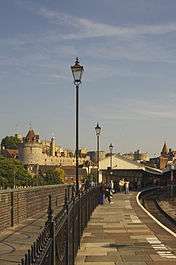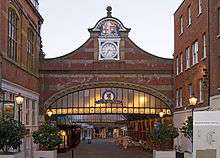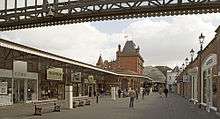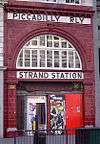Windsor & Eton Central railway station
Windsor & Eton Central station is one of two terminal stations serving the town of Windsor, Berkshire, England. Although a small part is still a railway station, most of the station building has been converted into a tourist-oriented shopping centre, called Windsor Royal Shopping.[1] It is situated on the High Street, almost immediately opposite Castle Hill, the main public entrance to Windsor Castle.
| Windsor & Eton Central | |
|---|---|
 The end of the branch line from Slough: the truncated Platform 1, with the towers of Windsor Castle visible in the background | |
| Location | |
| Place | Windsor |
| Local authority | Windsor and Maidenhead |
| Grid reference | SU966769 |
| Operations | |
| Station code | WNC |
| Managed by | Great Western Railway |
| Number of platforms | 1 |
| DfT category | D |
| Live arrivals/departures, station information and onward connections from National Rail Enquiries | |
| Annual rail passenger usage* | |
| 2014/15 | |
| – Interchange | |
| 2015/16 | |
| – Interchange | |
| 2016/17 | |
| – Interchange | |
| 2017/18 | |
| – Interchange | |
| 2018/19 | |
| – Interchange | |
| History | |
| Original company | Great Western Railway |
| Pre-grouping | GWR |
| Post-grouping | GWR |
| 8 October 1849 | Opened as Windsor |
| 1 June 1904 | Renamed Windsor and Eton |
| 26 September 1949 | Renamed Windsor and Eton Central |
| National Rail – UK railway stations | |
| * Annual estimated passenger usage based on sales of tickets in stated financial year(s) which end or originate at Windsor & Eton Central from Office of Rail and Road statistics. Methodology may vary year on year. | |
Originally named simply Windsor, the station was renamed twice: first to Windsor & Eton on 1 June 1904; and then, following nationalisation of the railways, to Windsor & Eton Central on 26 September 1949.[2]
The station is the terminus of a branch line from Slough operated by Great Western Railway. It is 21 miles 19 chains (34.2 km) measured from London Paddington via Slough. Windsor's other station, Windsor & Eton Riverside, is the terminus for the South Western Railway service from London Waterloo.
History
Construction

Windsor Station opened on 8 October 1849[2] on the completion of the branch line from Slough but only after considerable opposition from the leadership at Eton College, which was convinced that the proximity of a railway would lead the Eton boys astray.[3]
An extension of the branch was planned in 1871–72 to connect to the south via Dedworth and Ascot. It was planned to diverge west from the viaduct, just to the south of the river bridge. Despite reaching an advanced stage of design and with some property purchased plus the construction of a possible station building, the plans were never completed and were abandoned completely by 1914.[4]
The Metropolitan and District railways
When, in 1863, the Metropolitan Railway opened the world's first underground railway, between Paddington and Farringdon Street in the City of London, the Great Western Railway ran regular through services to Windsor from Farringdon. Initially these were broad gauge trains, as the original Metropolitan was laid for mixed standard and broad gauges and, for some months, the engines and coaches were hired from the GWR. By 1865, there were ten trains daily on the route.[3]
Later the District Railway expanded its services to the west of London. On 1 March 1883, it started a service to Windsor from Mansion House, using the Great Western main line. The trains were not popular, possibly because of the unsuitability of using four-wheel coaches for the non-stop section between Ealing Broadway and Slough and possibly also because Windsor was both too affluent and too far from the City to make commuting attractive. The service was discontinued on 30 September 1885.[3][5][6][7][8]
The structure
The station is approached by a 2,035-yard (1.861 km) brick viaduct and Windsor Railway Bridge, the last surviving wrought iron bridge designed by Brunel.[9] The original building was little more than a glorified train shed. This was completely rebuilt by the GWR for Queen Victoria's Diamond Jubilee, with a much grander frontage and an interior reminiscent of Paddington. Two island platforms and a bay on the south side were provided.
The goods yard
Windsor & Eton Central railway station | ||||||||||||||||||||||||||||||||||||||||||||||||||||||||||||||||||||||
|---|---|---|---|---|---|---|---|---|---|---|---|---|---|---|---|---|---|---|---|---|---|---|---|---|---|---|---|---|---|---|---|---|---|---|---|---|---|---|---|---|---|---|---|---|---|---|---|---|---|---|---|---|---|---|---|---|---|---|---|---|---|---|---|---|---|---|---|---|---|---|
| ||||||||||||||||||||||||||||||||||||||||||||||||||||||||||||||||||||||
To the north of the station, a large goods yard was laid out between the station and the River Thames at ground level. Since the station was built somewhat higher up, the yard had to be reached by a steep incline built against the side of the viaduct. It sloped down towards a short headshunt, near the river bridge, which allowed switchback access to the yard sidings. This arrangement limited the number of wagons that could be transferred to and from the sidings in one go. In addition to serving the populace of Windsor and surrounding area, the yard provided a depot for Windsor gas works, receiving loads of coal and removing coke and tar.
When freight services were stopped in the 1960s, the goods yard and incline were removed. The yard became a coach park but, on the side of the viaduct, it is possible to see where the incline was.
Decline
On 17 November 1968, platforms 3 and 4 were taken out of use. On 5 September 1969, platform 2 was decommissioned as well. Later, the remaining platform was also truncated, twice, at each rebuild of the station.
Royalty & Empire
In 1982 British Railways and Madame Tussauds restored the station, creating an exhibition called Royalty & Empire (initially Royalty & Railways). The exhibition recalled the Diamond Jubilee of Queen Victoria in 1897, using displays of wax models and an audio-visual show featuring early Audio-Animatronic figures.
After entering the exhibition via the ticket office, visitors would be greeted by a scene on the platform depicting the arrival of the Royal Train, complete with figures of station staff and a full size replica train.
A full-size replica steam locomotive GWR 3031 Class named The Queen was built at Steamtown, Carnforth, and this was combined with an ex-South Eastern and Chatham Railway tender and fittings from a GWR tender. The locomotive's bogie and rear wheels are also from another GWR tender, but the large driving wheels are only half complete (the lower half) and they do not sit directly on the rails. This allowed the locomotive to be rolled into position when the exhibition was built. The replica was completed in December 1982 and delivered by road in January 1983. Two mobile cranes hoisted it onto the viaduct, then it was rolled into position on temporary track.[11] Tussaud's fitted smoke and steam generators so that steam was emitted from the cab, whistles and safety valves, and smoke from the chimney. A sound unit was also fitted.
Two carriages were used to form a replica of the Royal Train. Directly behind the loco was No. 229, a replica coach mounted on an ex-British Railways BG Full Brake underframe and containing waxwork figures of various members of the Royal Family. The second coach was the original Royal Day Saloon No. 9002 that was rescued for the exhibition from a cliff top in Aberporth, Wales.[12]
After leaving the platform, visitors could see the restored royal waiting room with figures of Queen Victoria and the Prince and Princess of Wales, before entering 'The Royal Parade' area. A walkway was constructed up and around the canopy, allowing visitors to view figures of the royal party exiting the waiting room and the queen boarding her Ascot landau. Over seventy wax figures of 2nd Battalion Coldstream Guards formed part of this scene.
The last part of the exhibit was the 'Sixty Glorious Years' audio-visual show. The show outlined the growth of Great Britain using slides and projections, before the screen sank to reveal moving animatronic figures of some of the great personalities of the Victorian age, including Queen Victoria herself.
The exhibition closed in the late 1990s and almost all of the exhibits were taken away. The locomotive The Queen was too expensive to remove, so, rather than being cut up, it was incorporated as a feature of a restaurant on the concourse where it remains today.[13] The tender – the only original (and historic) part of the replica engine – was sold to a scrap dealer and cut up, although the springs and axleboxes were salvaged for use in the replica LB&SCR Atlantic project at the Bluebell Railway, and part of one side was rescued by the Slough and Windsor Railway Society, where it is now on display.
The original Royal Saloon No.9002 was preserved at the Museum of the Great Western Railway. It is not known what happened to the replica coach.
The Royal Waiting Room is part of a restaurant on the concourse.
Windsor Link Railway
The Windsor Link Railway was a 2009 proposal for a new railway connecting the Great Western and South West Trains franchise areas and potentially linking both to Heathrow Airport. Windsor & Eton Central and Windsor & Eton Riverside railway stations would be replaced with one through-route station in the Windsor Goswells.
The proposal was rejected by the Government in December 2018.[14]
In film
Being not far from Pinewood Studios, Central station was extensively used in Carry On Loving, one of the Carry On films. The film was released in 1970, at which time much of the original station was still intact. In the opening sequence, the station doubles as 'Much-Snogging-On-The-Green', where Terry Scott's character boards a British Rail DMU. Later in the film, the taxi rank and approaches to the station are used as Sidney Bliss (Sid James) boards a taxi after being followed into the toilets by Charles Hawtrey in disguise.
Railway scenes in the Robert Donat film Lease of Life (1954) were filmed at Windsor & Eton Central station.
Services
Windsor & Eton Central station is served by a Great Western Railway operated shuttle service from Slough. The journey takes 6 minutes each way, and return trips run every 20 minutes. At Slough, there are connections with stopping and semi-fast services to Reading and London Paddington, operated by Great Western Railway. Typical journey times from Slough are 15–30 minutes to Reading and 20–40 minutes to Paddington.[15]
| Preceding station | Following station | |||
|---|---|---|---|---|
| Terminus | Great Western Railway Windsor branch |
Slough | ||
| Historical railways | ||||
| Preceding station | Following station | |||
| Terminus | District line | towards Mansion House |
||
| Terminus | Great Western Railway Windsor branch |
Chalvey Halt Line open, station closed | ||
References
- "Centre Information". Windsor Royal Shopping. Retrieved 20 September 2014.
- Butt, R.V.J. (1995). The Directory of Railway Stations. Yeovil: Patrick Stephens Ltd. p. 252. ISBN 1-85260-508-1. R508.
- Wolmar, Christian. The Subterranean Railway. ISBN 1-84354-023-1.
- "The Railway from Windsor to Ascot". The Royal Windsor Web Site History Zone. Archived from the original on 11 April 2011. Retrieved 10 April 2011.
- Connor, Piers (1993). "The District Looks West". Going Green: The Story of the District Line. Harrow Weald: Capital Transport. pp. 14, 16. ISBN 1-85414-157-0.
- Day, John R. (1963). "The Metropolitan District and the Inner Circle". The Story of London's Underground (1st ed.). Westminster: London Transport. pp. 24–25.
- Demuth, Tim (2004). "1881–1890". The Spread of London's Underground (2nd ed.). Harrow: Capital Transport. pp. 8–9. ISBN 1-85414-277-1.
- Rose, Douglas (December 2007) [1980]. The London Underground: A Diagrammatic History (8th ed.). Harrow Weald: Capital Transport. ISBN 978-1-85414-315-0.
- Design, Green Jersey Web. "Heritage Locations - South East - Berkshire - Windsor Railway Bridge". www.transportheritage.com. Retrieved 21 November 2016.
- "Britain from Above". English Heritage. Retrieved 24 March 2016.
- George, Hinchcliffe (March 1983). Slater, John (ed.). "Gentlemen - 'The Queen'". Railway Magazine. Vol. 129 no. 983. Sutton: IPC Transport Press. pp. 91–92. ISSN 0033-8923.
- Slater, John, ed. (March 1983). "Windsor's Royal Welcome". Railway Magazine. Vol. 129 no. 983. Sutton: IPC Transport Press. pp. 88–89. ISSN 0033-8923.
- "Madame Tussauds Royal Train Exhibition at Windsor in 1994". Youtube. BritishRailwayTV. 7 October 2012. Retrieved 6 March 2015.
- Smale, Katherine (7 December 2018). "Exclusive - Windsor to Heathrow rail scheme 'rejected outright'". New Civil Engineer.
- "Buy train tickets and check train times - Great Western Railway". www.gwr.com. Retrieved 11 November 2019.
External links
| Wikimedia Commons has media related to Windsor and Eton Central railway station. |
- Train times and station information for Windsor & Eton Central railway station from National Rail
- Historic England. "Details from listed building database (1204606)". National Heritage List for England.

